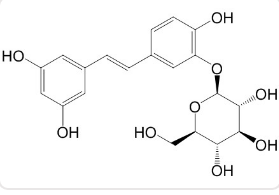Home
Products
Piceatannol 3'-O-glucoside



| Product Name | Piceatannol 3'-O-glucoside |
| Price: | $176 / 10mg |
| Catalog No.: | CN03755 |
| CAS No.: | 94356-26-0 |
| Molecular Formula: | C20H22O9 |
| Molecular Weight: | 406.4 g/mol |
| Purity: | >=98% |
| Type of Compound: | Phenols |
| Physical Desc.: | Powder |
| Source: | The roots of Rheum palmatum L. |
| Solvent: | DMSO, Pyridine, Methanol, Ethanol, etc. |
| SMILES: | OC[C@H]1O[C@@H](Oc2cc(ccc2O)/C=C/c2cc(O)cc(c2)O)[C@@H]([C@H]([C@@H]1O)O)O |
| Contact us | |
|---|---|
| First Name: | |
| Last Name: | |
| E-mail: | |
| Question: | |
| Description | Piceatannol 3'-O-glucoside, an active component of Rhubarb, activates endothelial nitric oxide (NO) synthase through inhibition of arginase activity with IC50s of 11.22 µM and 11.06 µM against arginase I and arginase II, respectively. |
| Target | NO synthase[1] IC50: 11.22 μM (Arginase I), 11.06 μM (Arginase II)[1] |
| In Vitro | Piceatannol 3'-O-glucoside (Piceatannol-3'-O-β-D-glucopyranoside; PG) is a potent component of stilbenes, inhibits the activity of arginase I and II prepared from mouse liver and kidney lysates, respectively, in a dose-dependent manner. In human umbilical vein endothelial cells, incubation of Piceatannol 3'-O-glucoside markedly blocks arginase activity and increases nitrite and nitrate (NOx) production, as measured by Griess assay. In liver lysates, incubation of different concentrations of Piceatannol 3'-O-glucoside significantly decreases arginase I activity (75±5% at 1 µM, 72±7% at 3 µM, 62±1% at 10 µM) compared to untreated control (100±9%). In kidney lysates, the residual arginase activities after incubation of 1, 3 and 10 µM Piceatannol 3'-O-glucoside are 75±6, 74±5, and 53±8%, respectively. Arginase activity is measured in the presence of different concentration of Piceatannol 3'-O-glucoside (from 0 to 120 µM) using liver lysate and kidney lysate. The 50% inhibitory concentrations (IC50) are 11.22 µM for the liver lysate and 11.06 µM for kidney lysate. The values are obtained using the software of Graphpad prizm 4.0. Piceatannol 3'-O-glucoside inhibits arginase activity and increases NO production in HUVECs. Piceatannol 3'-O-glucoside inhibits lipoxygenase activity upto 66% at the concentration of 100 µM and IC50 value is 69 µM[1]. |
| In Vivo | In order to ascertain whether Piceatannol 3'-O-glucoside (PG) ameliorates vascular function in wild-type (WT) and atherogenic model mice [apolipoprotein E-null mice (ApoE-/-)] and to investigate the possible underlying mechanism. Preincubation of aortic vessels from WT mice fed a normal diet (ND) with Piceatannol 3'-O-glucoside attenuates vasoconstriction response to U46619 and phenylephrine (PE), while the vasorelaxant response to acetylcholine (Ach) is markedly enhanced in an endothelium-dependent manner. Piceatannol 3'-O-glucoside treatment attenuates the phenylephrine (PE)-dependent contractile response, and significantly improves the acetylcholine (Ach)-dependent vasorelaxation response in aortic rings from ApoE-/- mice fed a high-cholesterol diet (HCD). Piceatannol 3'-O-glucoside administration in the drinking water significantly reduces fatty streak formation in ApoE-/- mice fed an HCD[2]. |
| Animal Admin | Mice[2] Twenty 10-week-old male wild-type (WT) (C57BL/6J) and ApoE-/- mice are studied. To determine the effect of Piceatannol 3'-O-glucoside on vascular reactivity, aortic rings isolated from 20 male C57BL/6J WT mice fed a normal diet (ND) and 20 male ApoE-/- mice fed an HCD are studied for 6 weeks. Aortic rings are incubated with or without Piceatannol 3'-O-glucoside (50 μM) for 18 h. For the pathological assay, Piceatannol 3'-O-glucoside is administered in the drinking water to ApoE-/- mice for 6 weeks when the mice are started on the HCD. Given that each mouse consumes ~10 mL water/day this represents a daily dose of ~500 μg/mouse/day of Piceatannol 3'-O-glucoside[2]. |
| Density | 1.6±0.1 g/cm3 |
| Boiling Point | 721.6±60.0 °C at 760 mmHg |
| Flash Point | 390.2±32.9 °C |
| Exact Mass | 406.126373 |
| PSA | 160.07000 |
| LogP | 0.04 |
| Vapour Pressure | 0.0±2.5 mmHg at 25°C |